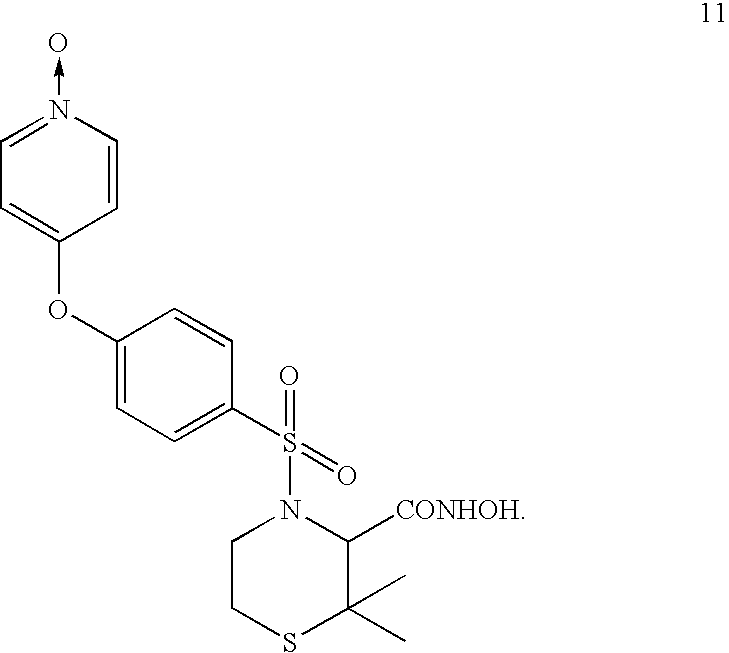Metabolites of prinomastat and their synthesis
a prinomastat and metabolite technology, applied in the field of prinomastat metabolites and their synthesis, can solve problems such as uncontrolled breakdown of extracellular matrix
- Summary
- Abstract
- Description
- Claims
- Application Information
AI Technical Summary
Benefits of technology
Problems solved by technology
Method used
Image
Examples
example 1a
Preparation and Purification of Metabolite M6
1. Acetylation of 4-Hydroxybenzensulfonic Acid Sodium Salt:
[0127]4-Hydroxybenzensulfonic acid sodium salt dihydrate (1400 g, 6.03 mol) was suspended in triethylamine (7 L) and acetic anhydride (1.7 L, 18.1 mol) was added over 1 hour. Exotherm to 70° C. was observed. When the temperature reached 70° C., a water bath was placed under the flask and used for cooling during the remainder of the acetic anhydride addition. The thick, gelatinous mixture was stirred at 20° C. for 15 hours. The solvent was removed by rotary evaporation under reduced pressure. The vacuum was controlled carefully to avoid bumping. Toluene (2 L) was added to the residue. Then, the mixture was concentrated by rotary evaporation. The toluene azeotrope was repeated giving a thick white suspension. The residue was suspended in ethyl acetate (8 L), and the mixture was refluxed for 1 hour. The mixture was cooled to 50° C., and the solid was collected by filtration, washed w...
example 1b
Alternative Preparation of Metabolite M6
1. Preparation of O-(tert-butlyldiphenylsilyl)-hydroxylamine:
[0137]Under nitrogen, a 50 L extractor was charged with dichloromethane (20 L), triethylamine (7.1 L, 50.9 mol), and hydroxylamine hydrochloride (1769 g, 25.5 mol). The mixture was stirred for 45 minutes then tert-butylchlorodiphenylsilane (7 kg, 25.5 mol) was added in seven 1 kg portions over 40 minutes. Additional dichloromethane (10 L) was added, filling the vessel to capacity. The joints were stoppered and the mixture stirred at 20° C. for 5 days. The resulting thick white suspension was filtered to remove the precipitate (mostly triethylamine hydrochloride). The filtrate was concentrated to a thick paste by rotary evaporation on two separate evaporators. Ethyl acetate (4 L) was added to each portion and evaporation continued until 2 L of solvent were condensed. The suspension from each half was combined in the 50-L reactor, ethyl acetate (28 L) was added, and the mixture was sti...
example 1c
Structural Characteristics of Metabolite M6 Synthetic Standard
[0145]The authentic standard metabolite M6 is the pyridine N-oxide analogue of prinomastat, and its product ion mass spectrum showed fragment ions at m / z 129, 186, 187, and 252.
[0146]The 1H and 13C chemical shifts of metabolite M6 authentic standard were assigned by comparative analysis with prinomastat and confirmed by 1H-13C correlation experiments (HMQC and HMBC). The chemical shifts of the protons adjacent to the pyridine N-oxide nitrogen (δ 8.19) are upfield-shifted from those of the parent drug prinomastat (δ 8.51), as expected from established values for pyridine N-oxide and pyridine (see Pretsch et al., Spectral Data for the Determination of Organic Compounds, 2nd Ed., Springer-Verlag (1989)). When compared to the parent drug, only the pyridine N-oxide moiety of metabolite M6 gives rise to significant 1H and 13C chemical shift differences. All other 1H and 13C chemical shifts were essentially unchanged from those ...
PUM
| Property | Measurement | Unit |
|---|---|---|
| weight | aaaaa | aaaaa |
| weight | aaaaa | aaaaa |
| weight | aaaaa | aaaaa |
Abstract
Description
Claims
Application Information
 Login to View More
Login to View More - R&D
- Intellectual Property
- Life Sciences
- Materials
- Tech Scout
- Unparalleled Data Quality
- Higher Quality Content
- 60% Fewer Hallucinations
Browse by: Latest US Patents, China's latest patents, Technical Efficacy Thesaurus, Application Domain, Technology Topic, Popular Technical Reports.
© 2025 PatSnap. All rights reserved.Legal|Privacy policy|Modern Slavery Act Transparency Statement|Sitemap|About US| Contact US: help@patsnap.com



